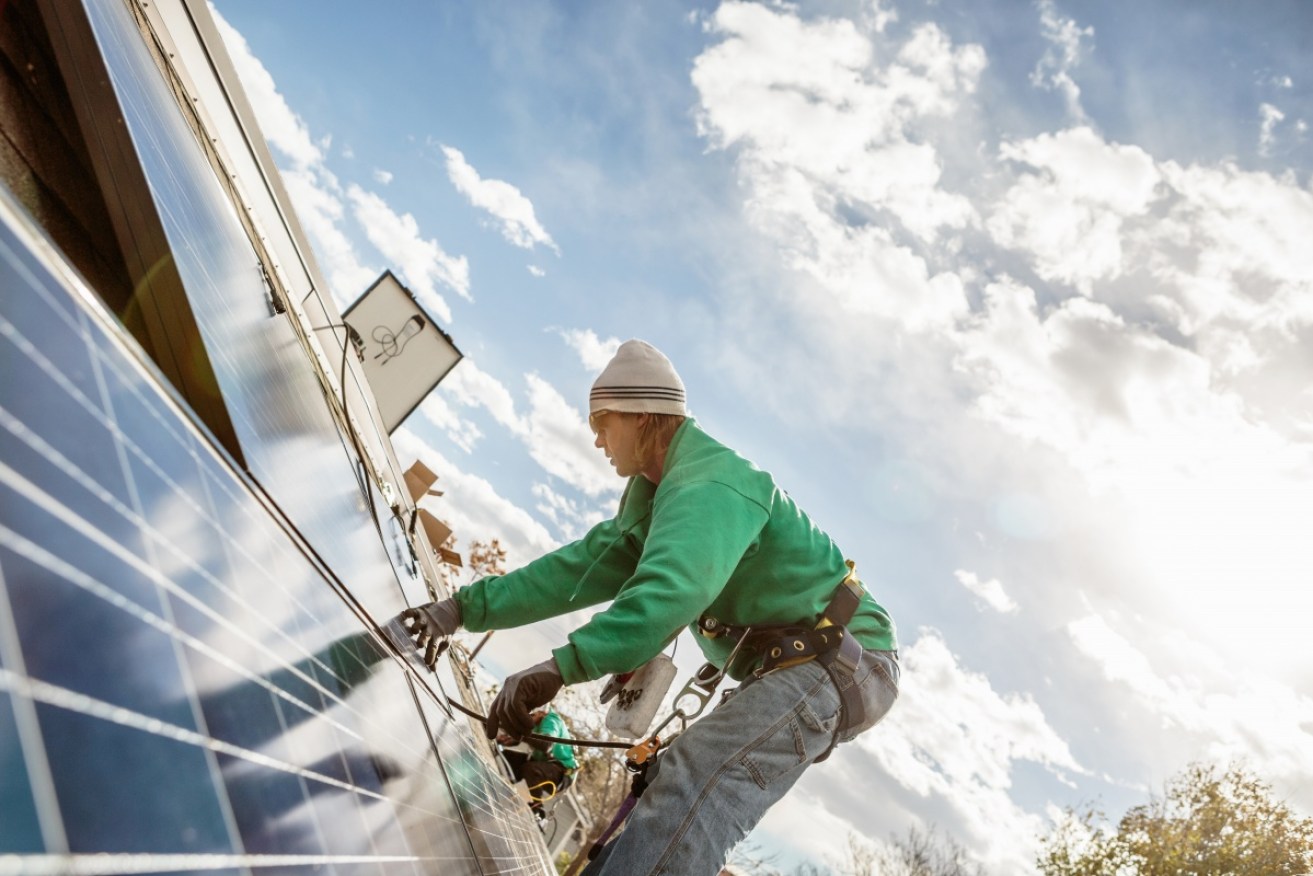The Finkel review could unleash a wave of renewables jobs

Rooftop solar has led the way, but large-scale projects could create vastly more jobs. Photo: Getty
Far from worsening unemployment, Australia’s transition away from fossil fuels could create hundreds of blue collar jobs if Canberra uses the impetus of the Finkel review to turn the nation into a market leader in renewables.
Kane Thornton, CEO of the Clean Energy Council, the peak body for the renewables industry, said he was optimistic the inevitable decline of coal could result in net job creation, not destruction.
“Right now there is unprecedented activity underway in the renewable sector and if we get investment certainty and apolitical support then we can expect that to continue,” he told The New Daily.
Mr Thornton said a lot is riding on Chief Scientist Alan Finkel’s energy review, due Friday. Dr Finkel is expected to recommend a ‘Low Emissions Target’ or ‘Clean Energy Target’, to replace the current Renewable Energy Target that expires in 2020.
Business groups desperately want policy certainty. If both major parties unite behind Dr Finkel it could unleash a wave of blue collar job creation to help offset the loss of auto manufacturing, Mr Thornton said.
He gave the example of solar panel railings. With policy certainty and a steady stream of large-scale projects, Australian businesses could build the railings instead of importing from Asia.
The Clean Energy Council says more than 30 large-scale renewables projects will be started or completed this year, worth almost $7 billion in investment and 3725 new direct jobs.
This will recover lost ground. According to the latest official data, there were just over 11,000 jobs in renewables in 2015-16, well below the highs of 16,000-19,000 during the rooftop solar boom of 2010-2013, driven by Labor government subsidies and direct investment.
Many experts blame the Coalition’s termination of the carbon price and cuts to the Renewable Energy Target for the downturn in renewables jobs, and are optimistic the trend will correct after the Finkel review.
“I won’t take a guess at where exactly the jobs number will land in 2016-17, but I’m expecting we’ll be at record levels – and long may it continue,” Mr Thornton said.
In 2016, renewables generated roughly 17 per cent of Australia’s energy and employed about 11,000 workers. According to Origin Energy, coal provides about 70 per cent of Australia’s energy, and according to the World Coal Association, it employs about 180,000 Australians. So there is a lot of ground to retrace.
However, renewables seems to rely on more workers per unit of electricity generation than conventional energy, presumably because fossil fuel generation is heavily mechanised and automated.
Globally, renewables employed (directly and indirectly) 9.8 million people in 2016, according to a report by the International Renewable Energy Agency, compared to roughly 13 million (directly) in coal, oil and gas.
Exhaustive research by the UK’s Energy Research Centre in 2014 concluded that renewable energy generation is more labour intensive, both to construct and maintain.
Likewise, the Climate Council, an Australian research body, calculated that a 34 per cent renewable energy target would boost employment in electricity generation by about 44 per cent in 2030, and a 50 per cent target would boost employment by roughly 90 per cent.
Former Liberal leader Dr John Hewson, now an energy policy researcher at ANU, said Australia can become a “world leader” in renewables, with clear benefits to the labour market, so long as Canberra relinquishes “short-term politicking”.
“Renewables projects are some of the most shovel-ready infrastructure projects around and they all have significant job prospects in the construction phase and most of them have sustained job prospects – not as many, obviously – in the operation and management stage,” Dr Hewson told The New Daily.
“We have the best sun and wind in the world. We have the technology to turn that into electricity, and we have the capacity to store it.
“All this short-term politicking of the last couple of decades has just burnt the opportunity that was otherwise there. It’s still there, we can still do it, but the industry needs certainty.”
Political parties may be forced to listen. A poll by the Lowy Institute, published Wednesday, found that four in five respondents wanted the government to encourage more renewable energy, even at greater cost.
Paul Bastian, national secretary of the Australian Manufacturing Workers Union, also called on the government to invest in renewables to create jobs.
“Lots of overseas examples show that there are high-skilled, secure jobs in renewable energy industries. With our abundant resources, Australia has a huge competitive advantage,” he told The New Daily.
“The problem is not a lack of demand or capital investment, it’s a lack of political willpower from our government. ‘Transition’ can’t just be a slogan.”








